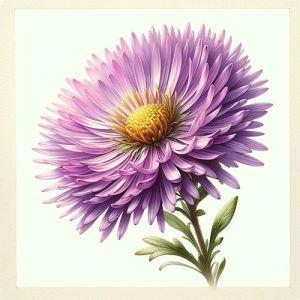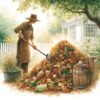Introduction to Asters
Welcome to our comprehensive guide on Asters, a beautiful addition to any garden, bringing a burst of late-season color and attracting pollinators. I just love these splendid flowers with their bright centers and perfect petals. Known for their daisy-like blooms and variety of vibrant hues, Asters are versatile and easy to grow, making them ideal for both beginners and experienced gardeners. This guide will provide you with the knowledge needed to cultavate and care for these stunning perennials.
Botanical Overview
Understanding Aster’s Botanical Roots
- Common Name: Aster
- Scientific Name: Aster spp.
- Family: Asteraceae Asters are native to Europe, Asia, and North America, and belong to the daisy family, Asteraceae. Their star-shaped flowers come in a wide range of colors, including blue, purple, pink, and white, and they thrive in various climates, making them a versatile choice for gardens worldwide.
Varieties of Aster
Exploring Different Varieties of Aster
- New England Aster (Symphyotrichum novae-angliae): Known for its large blooms and tall stature, perfect for garden beds and borders.
- New York Aster (Symphyotrichum novi-belgii): Offers a variety of colors and compact growth, making it suitable for smaller gardens.
- Wood’s Aster (Symphyotrichum dumosum): Dwarf variety with pink, blue, or white blooms, ideal for edging or rock gardens.
- Smooth Aster (Symphyotrichum laeve): Noted for its smooth leaves and pale blue flowers, adding a delicate touch to any garden. Each variety brings unique characteristics to the garden, allowing gardeners to create diverse and colorful displays.
The History and Cultural Significance of Asters
Asters have a rich history and cultural significance that spans centuries and continents. Native to Europe, Asia, and North America, Asters have been cultivated and appreciated for their beauty and medicinal properties.
Historical Significance In ancient Greece, Asters were associated with the goddess Astraea. According to mythology, when Astraea wept for the world’s declining virtue, her tears turned into Aster flowers, symbolizing love, faith, and wisdom. The name “Aster” itself comes from the Greek word for “star,” reflecting the flower’s star-like shape.
Throughout history, Asters have been used in various cultures for their medicinal properties. The flowers were traditionally used to treat ailments such as coughs, colds, and muscle aches, and the roots were used in herbal teas to relieve pain and inflammation.
Cultural Uses Asters are known for their symbolism and have played a role in cultural expressions across the globe:
- Language of Flowers: In Victorian flower language, Asters symbolized patience, elegance, and love, making them popular choices for bouquets and floral arrangements.
- Chinese Culture: In Chinese culture, Asters are associated with fidelity and have been used in traditional medicine for centuries.
- Modern Symbolism: Asters are the birth flower for September, symbolizing love and affection, and are also commonly associated with the autumn season, reflecting their late-blooming nature.
Modern Uses Today, Asters are celebrated for their vibrant colors and ecological benefits:
- Gardening: They are a popular choice for garden beds, borders, and containers, adding late-season color to gardens.
- Pollinator Support: Asters attract bees, butterflies, and other beneficial insects, enhancing garden ecosystems.
- Floristry: Asters are often used in floral arrangements and bouquets, adding a burst of color and symbolism.
Asters have not only graced gardens and landscapes throughout history but also carry deep cultural and symbolic meanings. Whether in gardens, floral arrangements, or traditional medicine, Asters continue to leave a lasting impression on cultures worldwide.
Planting and Growth Conditions
Creating Ideal Conditions for Aster Growth
- Sunlight: Asters thrive in full sun to partial shade.
- Soil: Prefer well-draining, moderately fertile soil with a pH between 6.0 and 7.5.
- Planting Tips: Best planted in early spring or fall. Space plants 12 to 18 inches apart for proper air circulation.
- Growing Zones: Asters generally thrive in USDA Hardiness Zones 3 through 8, making them suitable for a wide range of climates.
Care and Maintenance
Ensuring Healthy Asters
- Watering: Water regularly during dry spells, ensuring the soil remains moist but not waterlogged.
- Fertilizing: Apply a balanced fertilizer in early spring to support growth and blooming.
- Pruning: Deadhead spent blooms to encourage continuous flowering. Cut back in late fall to promote vigorous growth in the following season. Proper care and maintenance will keep Asters blooming vibrantly and prolong their blooming season.
Benefits and Uses
The Many Advantages of Growing Asters
- Aesthetic Appeal: Adds a burst of color to garden beds, borders, and containers.
- Pollinator Friendly: Attracts bees, butterflies, and other beneficial insects, supporting local ecosystems.
- Late-Season Blooms: Offers color and interest in the garden from late summer through fall. Incorporating Asters into your garden enhances its visual appeal while providing ecological benefits.
Potential Problems
Addressing Common Challenges with Asters
- Pests and Diseases: Watch out for powdery mildew and aphids. Ensure proper air circulation to prevent fungal diseases.
- Environmental Stress: Excessive heat and humidity can stress Asters, affecting bloom quality.
- Invasiveness: Some varieties may spread aggressively. Regular division and management can prevent this. Proactive care and management can mitigate these issues, keeping your Asters healthy.
Conclusion
Asters are a wonderful addition to any garden, offering vibrant blooms and ecological benefits. With the right care and growing conditions, these perennials can provide color and interest from late summer into fall. Whether you’re new to gardening or an experienced enthusiast, Asters offer a rewarding gardening experience. Embrace their beauty and watch your garden come to life.












You must be logged in to post a comment.